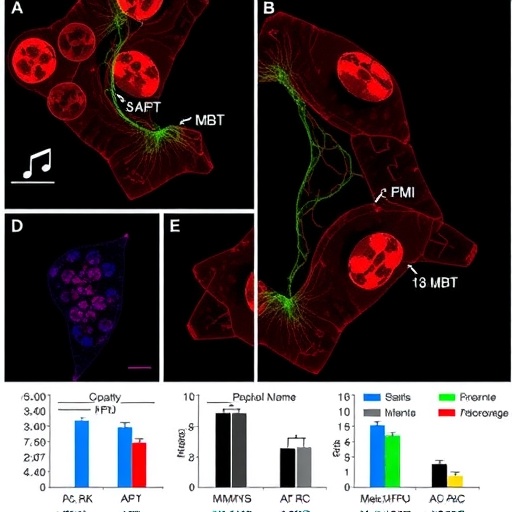Recent advancements in cancer immunotherapy have highlighted the importance of creative approaches to reprogramming tumor cells to elicit a robust immune response. A recent study conducted by Jiang et al. explores the potential of dimethyl fumarate (DMF) in transforming cervical cancer cells, thereby amplifying antitumor immunity. This groundbreaking research delves into the underlying mechanisms whereby DMF activates the mitochondrial DNA-cGAS-STING pathway, leading to enhanced immune activation against cervical tumors.
Dimethyl fumarate, a compound primarily recognized for its application in treating multiple sclerosis, has caught the attention of oncologists due to its immunomodulatory effects. The study conducted by Jiang and colleagues offers critical insights into how DMF may play a role beyond its existing applications, positioning it as a potential therapeutic agent in cancer treatment. The understanding of how DMF interacts with cancer biology could pave the way for innovative treatment strategies that enhance the body’s natural ability to fight tumors.
At the core of the study is the activation of the mitochondria’s DNA-cGAS-STING signaling pathway, which has emerged as a vital player in the immune response to tumors. Typically, tumor cells possess mechanisms that allow them to evade detection by the immune system, often creating an immunosuppressive environment. The researchers hypothesized that DMF could disrupt this ambiance and activate the cGAS-STING pathway, leading to a heightened immune response against cervical cancer cells.
The study’s design included the evaluation of cervical cancer cell lines treated with varying concentrations of DMF. The authors meticulously assessed the changes in cellular behavior after treatment, noting an increased expression of key immune signaling molecules. This response indicates that DMF not only alters tumor cell metabolism but also primes these cells for an interaction with components of the immune system, effectively rendering them more recognizable targets.
One of the most compelling findings was the significant increase in the release of mitochondrial DNA following DMF treatment. Mitochondrial DNA, when released into the cytoplasm of cells, can activate the cGAS-STING pathway. This cascade leads to the production of type I interferons, potent cytokines known for their ability to stimulate immune cells and promote an aggressive antitumor immune response.
Moreover, Jiang et al. uncovered additional layers of complexity in the immune activation process facilitated by DMF. The study suggests that the exposure to DMF impacts not just the cancer cells but also the surrounding immune cells, creating a more favorable environment for immune-mediated tumor rejection. The research identified enhanced infiltration of immune cells, such as T cells and dendritic cells, into the tumor microenvironment, which is often a hallmark of effective antitumor responses.
In the context of cervical cancer, where traditional treatment options can sometimes be limited or less effective, this study provides a promising alternative approach that could reshape how this malignancy is managed. By leveraging the body’s immune system to recognize and attack cancerous cells, the need for invasive procedures and chemotherapy may be mitigated, ultimately improving patient outcomes and quality of life.
The implications of this study extend beyond just cervical cancer, as the mechanistic insights into DMF’s action provide a framework applicable to other cancer types. The universality of the cGAS-STING pathway in immune response suggests that similar therapeutic strategies could be applied in diverse oncological contexts. Researchers may now consider investigating the efficacy of DMF in other malignant conditions, aiming to capitalize on its immune-enhancing properties.
Despite the promising results, further investigation is necessary to translate these laboratory findings into clinical practice. The study underlines the importance of not only understanding how DMF reprograms cancer cells but also identifying potential adverse effects and determining the optimal dosages. As researchers delve deeper into this novel approach, it may lead to the discovery of combinatory treatments that could maximize the efficacy of immunotherapy.
In summary, the work of Jiang et al. adds a significant chapter to the narrative of cancer immunotherapy. Dimethyl fumarate’s potential to reprogram cervical cancer cells demonstrates a thoughtful intersection of cellular biology and therapeutic strategy. The activation of the mtDNA-cGAS-STING pathway can serve as a powerful adjunct to existing cancer treatments, fostering a strong antitumor immune response.
Looking forward, it will be pivotal to explore the mechanisms further to streamline DMF’s application in clinical settings, potentially leading to a new era in the treatment of cervical cancer and beyond. The ongoing dialogue surrounding the role of immunotherapy in cancer has opened up incredible opportunities for hope and healing among patients grappling with this challenging disease. The landscape of cervical cancer treatment could soon be redefined, thanks to innovative research like that of Jiang et al., pushing the boundaries of what is therapeutically possible.
In a world where cancer continues to pose a severe health threat, findings like these reiterate the importance of interdisciplinary research and collaboration. The effort to understand cancer is ongoing, and studies such as these reinforce the critical role of the immune system in combating tumors, ensuring that future research is both inspired and informed by scientific inquiry.
By blending innovative therapies, like dimethyl fumarate, with our growing understanding of the immune landscape in cervical cancer, we set the stage for transformative approaches to treatment. This research marks a significant milestone in the quest for more effective cancer therapies, reaffirming the notion that the solutions may lie within our own immune responses, waiting to be awakened.
Ultimately, the study not only sheds light on a new potential use for dimethyl fumarate but also strengthens the argument for continued investment in immunotherapeutic strategies. As more studies emerge, the hope is to achieve customized, precision treatments that ensure individuals facing cancer receive the best possible care, tailored to harness their own immune systems against disease effectively.
By fostering an environment of continuous dialogue and inquiry, the science community can persist in its mission to innovate and improve outcomes for cancer patients globally. The insights gleaned from Jiang et al.’s research contribute significantly to this ongoing journey, highlighting both the challenges and the opportunities inherent in cancer research and therapeutics.
With each discovery and breakthrough, researchers inch closer to understanding the complexities of cancer biology, illuminating a path that could ultimately lead to cures and long-lasting remissions. The narrative of cancer treatment continues to evolve, and through dedicated investigation, we can anticipate a future where cancer becomes a manageable condition rather than a formidable foe.
Subject of Research: Dimethyl fumarate’s effect on cervical cancer and its role in enhancing antitumor immunity through the mtDNA-cGAS-STING pathway.
Article Title: Dimethyl fumarate reprograms cervical cancer cells to enhance antitumor immunity by activating mtDNA-cGAS-STING pathway.
Article References: Jiang, H., Liu, L., He, S. et al. Dimethyl fumarate reprograms cervical cancer cells to enhance antitumor immunity by activating mtDNA-cGAS-STING pathway. J Biomed Sci 32, 92 (2025). https://doi.org/10.1186/s12929-025-01187-x
Image Credits: AI Generated
DOI: 10.1186/s12929-025-01187-x
Keywords: Dimethyl fumarate, cervical cancer, immune response, mtDNA-cGAS-STING pathway, cancer immunotherapy.
Tags: cancer treatment innovationscervical cancer immunotherapycreative approaches in cancer immunologyDimethyl fumarate in cancer therapyenhancing antitumor immunityimmune activation against tumorsimmunomodulatory effects of DMFJiang et al. study findingsmitochondrial DNA-cGAS-STING pathwayovercoming immune evasion in tumorstherapeutic agents for cervical cancertumor cell reprogramming





